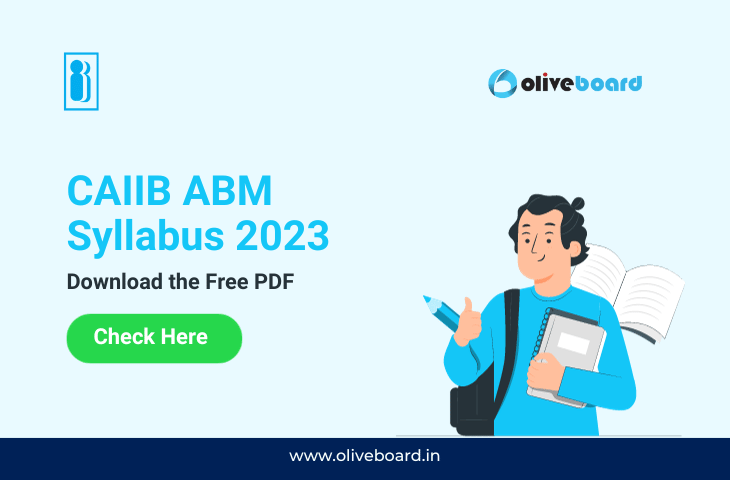CAIIB ABM Syllabus 2023
IIBF is going to conduct the November/December cycle of CAIIB 2023 on the 26th of November, 3rd, 9th, 10th, and 17th of December 2023. Candidates who are aspiring to appear for this cycle of the CAIIB must be aware of the detailed syllabus of the ABM Paper. Advance Bank Management Paper will be conducted on 26th November 2023. This blog will provide you with the detailed CAIIB ABM Syllabus 2023.
CAIIB 2023 – Overview
Candidates who will be appearing for the examination must be aware of the overall details of the CAIIB. We have mentioned below the overview details of the CAIIB 2023 for the candidates.
| CAIIB 2023 | Details |
| Name of organization | Institute of Banking and Finance |
| Institution | Indian Institute of Banking & Finance (IIBF) |
| Name of Examination | CAIIB exam |
| Eligibility | Members Only |
| Mode of Application | Online |
| Mode of exam | Online written exam |
| Exam conducted | Twice a year |
| Official website | iibf.org.in |
CAIIB ABM Syllabus
Advance Bank Management is one of the compulsory papers of the CAIIB 2023. ABM Paper consists of four modules each having a number of units. Candidates should be aware of the detailed topi-wise syllabus for the ABM. We have mentioned below the brief syllabus of the Advance Bank Management for all the aspiring candidates.
Statistics: Module A
| Units | Topics |
| Definition of Statistics, Importance & Limitations & Data Collection, Classification & Tabulation | Importance of Statistics Functions of Statistics Limitation or Demerits of Statistics Definitions; Collection of Data; Classification and Tabulation; Frequency Distribution |
| Sampling Techniques | Random Sampling Sampling Distributions Sampling from Normal Populations Sampling from NonNormal Populations Central Limit Theorem Finite Population Multiplier |
| Measures of Central Tendency & Dispersion, Skewness, Kurtosis | Arithmetic Mean Combined Arithmetic Mean Geometric Mean Harmonic Mean Median and Quartiles Mode Introduction to Measures of Dispersion Range and Coefficient of Range; Quartile Deviation and Coefficient of Quartile Deviation Standard Deviation and Coefficient of Variation Skewness and Kurtosis |
| Correlation and Regression | Scatter Diagrams Correlation Regression Standard Error of Estimate |
| Time Series | Variations in Time Series Trend Analysis Cyclical Variation Seasonal Variation Irregular Variation Forecasting Techniques |
| Theory of Probability | Mathematical Definition of Probability Conditional Probability Random Variable Probability Distribution of Random Variable Expectation and Standard Deviation Binomial Distribution Poisson Distribution Normal Distribution Credit Risk Value at Risk Option Valuation |
| Estimation | Estimates Estimator and Estimates Point Estimates Interval Estimates Interval Estimates and Confidence Intervals Interval Estimates of the Mean from Large Samples Interval Estimates of the Proportion from Large Samples |
| Linear Programming | Graphic Approach Simplex Method |
| Simulation | Simulation Exercise Simulation Methodology |
Human Resource Management in Bank: Module B
| Units | Topics |
| Fundamentals of Human Resource Management | The Perspective Relationship between HRM & HRD and their Structure and Functions Role of HR Professionals Strategic HRM Development of HR Functions in India |
| Development of Human Resources | HRD and its Subsystems Learning and Development – Role and Impact of Learning Attitude Development Career Path Planning Self-Development Talent Management Succession Planning |
| Human Implications of Organisations | Human Behaviour and Individual Differences Employees Behaviour at Work Diversity at Workplace and Gender Issues Theories of Motivation and their Practical Implication ‘Role’ : Its Concept & Analysis |
| Employees’ Feedback and Reward System | Employees’ Feedback Reward and Compensation System |
| Performance Management | Appraisal Systems Performance Review and Feedback Counselling Competency Mapping and Assessment of Competencies Assessment Centres Behavioural Event Interview (BEI) |
| Conflict Management and Negotiation | Conflict: Concept & Definition Characteristics of Conflict; Types of Conflicts Reasons for Conflict Different Phases of Conflict Conflict Resolution Conflict Management Negotiation Skills for Resolution of Conflicts |
| HRM and Information Technology | Role of Information Technology in HRM HR Information and Database Management Human Resource Information System (HRIS) Human Resource Management System (HRMS) e–HRM HR Research Knowledge Management Technology in Training HR Analytics |
Credit Management- Module C
| Units | Topics |
| Overview of Credit Management | Importance of Credit Historical Background of Credit in India Principles of Credit Types of Borrowers Types of Credit Components of Credit Management Role of RBI Guidelines in Bank’s Credit Management |
| Analysis of Financial Statements | Which are the Financial Statements Users of Financial Statements Basic Concepts Used in Preparation of Financial Statements Accounting Standards (AS) Legal Position Regarding Financial Statements Balance Sheet Profit and Loss Account Cash Flow Statement Funds Flow Statement Projected Financial Statements Purpose of Analysis of Financial Statements by Bankers Rearranging the Financial Statements for Analysis Techniques used in Analysis of Financial Statements Creative Accounting Related Party Transactions |
| Working Capital Finance | Concept of Working Capital Working Capital Cycle Importance of Liquidity Ratios Methods of Assessment of Bank Finance Working Capital Finance to Information Technology and Software Industry Bills/Receivables Finance by the Banks Guidelines of RBI for Discounting/Rediscounting of Bills by Banks Trade Receivables Discounting System (TReDS) Non-Fund Based Working Capital Limits Other Issues Related to Working Capital Finance |
| Term Loans | Important Points about Term Loans Deferred Payment Guarantees (DPGs) Difference between Term Loan Appraisal and Project Appraisal Project Appraisal Appraisal and Financing of Infrastructure Projects |
| Credit Delivery and Straight Through Processing | Documentation Third-Party Guarantees Charge over Securities Possession of Security Disbursal of Loans Lending under Consortium/Multiple Banking Arrangements Syndication of Loans StraightThrough Loan Processing or Credit Underwriting Engines |
| Credit Control and Monitoring | Importance and Purpose Available Tools for Credit Monitoring/Loan Review Mechanism (LRM) |
| Risk Management and Credit Rating | Meaning of Credit Risk Factors Affecting Credit Risk Steps taken to Mitigate Credit Risks Credit Ratings Internal and External Ratings Methodology of Credit Rating Use of Credit Derivatives for Risk Management RBI guidelines on Credit Risk Management Credit Information System |
| Restructuring/Rehabilitation and Recovery | Credit Default/Stressed Assets/NPAs Wilful Defaulters Non-cooperative borrowers Options Available to Banks for Stressed Assets RBI Guidelines on Restructuring of Advances by Banks Available Frameworks for Restructuring of Assets Sale of Financial Assets |
| Resolution of Stressed Assets under Insolvency and Bankruptcy Code 2016 | Definition of Insolvency and Bankruptcy To Whom the Code is Applicable; Legal Elements of the Code Paradigm Shift Corporate Insolvency Resolution Process Liquidation process Pre-packed Insolvency Resolution Process for stressed MSMEs |
Compliance in Banks and Corporate Governance – Module D
| Units | Topics |
| Compliance Function in Banks | Compliance Policy Compliance Principles Process and Procedures Compliance Programme Scope of Compliance Function Role & Responsibilities of Chief Compliance Officer (CCO) |
| Compliance Audit | Role of Risk Based Internal Audit and Inspection Reporting Framework and Monitoring Compliance Disclosure Requirements; Accounting Standards Disclosures under Listing Regulations of SEBI |
| Compliance Governance Structure | Organisational Structure Responsibility of the Board and Senior Management Compliance Structure at the Corporate Office Functional Departments Compliance Structure at Field Levels Internal Controls and its Importance |
| Framework for Identification of Compliance Issues and Compliance Risks | Compliance Issues Compliance Risk Inherent Risk and Control Risk Independent Testing and Effective Audit Programme Reporting Framework and Monitoring Compliance Role of Inspection and Audit Loan Review Mechanism/Credit Audit What is Good Compliance |
| Compliance Culture and GRC Framework | How to Create Compliance Culture Across the Organisation Governance Risk and Compliance – GRC Framework; Benefits of an Integrated GRC Approach Whistle-blower Policy The Components of a Whistle-blower Policy Reasons for Compliance Failures |
| Compliance Function and Role of Chief Compliance Officer in NBFCs | Framework for Scale Based Regulation for Non-Banking Financial Companies Transition Path Framework for Compliance Function and Role of Chief Compliance Officer in Non-Banking Financial Companies in Upper Layer and Middle Layer (NBFC-UL & NBFC-ML) |
| Fraud and Vigilance in Banks | Definition of Fraud Definition of Forgery Areas in which Frauds are committed in Banks Banking and Cyber Frauds Fraud Reporting and Monitoring System Vigilance Function in Banks RBI Guidelines for Private Sector and Foreign |
CAIIB ABM Syllabus PDF
The ABM Syllabus PDF will help candidates in accessing the syllabus whenever they need and they can save it for future reference. We have mentioned below the direct link to download the CAIIB ABM Syllabus PDF for all aspiring candidates.
We hope this blog gave you a better understanding of the CAIIB ABM Syllabus 2023. To read more such blogs, visit the Oliveboard website!
- NABARD Grade A Notification 2024, Exam Date Out for 102 Vacancies
- SBI PO Syllabus 2024, Check Exam Pattern for Prelims and Mains
- SBI PO Selection Process 2024, Written, Interview, GD
- SBI Clerk Syllabus 2024 and Exam Pattern For Prelims and Mains
- SSC Stenographer Exam Date 2024, Detail Exam Schedule
CAIIB ABM Syllabus 2023 – Frequently Asked Questions
Ans. Candidates can check the detailed CAIIB ABM Syllabus mentioned in this blog.
Ans. The ABM Paper 2023 will be conducted on 26th November 2023.

Hey everyone, I’m Vaishnavi Kumari, an edtech writer and a dedicated aspirant for government exams, including banking and SSC exams. Having worked with several edtech platforms, I am committed to providing you with essential and accurate information to ace these exams. With my experience as both a writer and an aspirant, I understand your needs and challenges, and my aim is to make your preparation journey smoother. I’ll focus on specific sections of the exams, compiling comprehensive and helpful content that covers the crucial topics, tips, and strategies you need to succeed. Let’s conquer these exams together!
Oliveboard Live Courses & Mock Test Series
- Monthly Current Affairs 2024
- Download RBI Grade B PYQ PDF
- Download IFSCA Grade A PYQs
- Download SEBI Grade A PYQs
- Attempt Free SSC CGL Mock Test 2024
- Attempt Free IBPS Mock Test 2024
- Attempt Free SSC CHSL Mock Test 2024
- Download Oliveboard App
- Follow Us on Google News for Latest Update
- Join Telegram Group for Latest Govt Jobs Update

